The Noodler's Flex Pen I am reviewing today is the most inexpensive fountain pen with a flexible nib on the market today. At $14 no other flex pen comes close. Not only that, but the overwhelming majority of fountain pen makers do not want to produce pens with flex nibs, probably because those pens belong to a bygone era. Well, the truth is there simply isn't a big market for them nowadays.
I am calling my pen "v2" not because it's an official designation but because it is part of the second large batch of flex pens produced by Noodler's Ink. Between the two batches there was a long delay of many months in which people were driven to distraction because they couldn't get their flex pen fix.
As far as I know, the only thing that differentiates pens from batch 1 and 2 is the fact that batch 1 pens needed to have their feed heat-set by hand, while the second batch improved the manufacturing process such that manual setting wasn't needed. This also allowed these pens to be produced quicker, eliminating the shortage.
Body and materials
Noodler's Flex Pens are identical to their piston fillers. Same body, same materials, both use a piston filling mechanism. The only things that differ are the nib and feed. For that reason, I will direct you to my previous review of Noodler's piston filler where you can read all about the body, since the same observations apply here.
Something must be said about the materials used. My piston filler was a clear demonstrator while the flex pen is an opaque blue with white swirls which Noodler's calls Lapis Inferno. It's quite a nice color; the blue is vibrant and cheerful. Having said that, I believe that the plastic used in flex is different than the piston filler.
The piston filler is made from some sort of "vegetal resin", which also gives it a very pungent smell (or stench if you will). The smell goes away after a while. I didn't notice the Lapis Inferno pen having such a powerful smell. At any rate, I cleaned it with rubbing alcohol to kill the smell in the crib.
The material of the blue pen also seems a bit rubbery to me, in contrast with the demonstrator which gave me some trouble and ended up in the trash. Note to self: don't soak Noodler's pens in ammonia solution for extended periods of time.
Nib and feed
The nib and feed of the flex pen are different than those in the piston filler. Both feeds are made from ebonite but the one on the flex pen is longer and has an additional ink channel on the front. Is the extra length meant to give improved flow as more of the feed sits inside the section? Perhaps.
The nib on the flex pen is split down the middle all the way into the section and apparently this is what helps it flex. It doesn't have a breather hole like the nib on the piston filler.
Ink flow is good - once you get the pen started. This seems to be the one problem that Noodler's piston fillers/flex pens suffer from: the ink tends to dry up in it if you don't use it for a longer period of time.
The trick with Noodler's pens is that you can easily adjust ink flow, something that much more expensive fountains pen don't allow. My understanding is that for more flow the feed must be deeper inside the section. For less, more of the feed needs to be outside.
This is a pen that requires experimentation to get the best out of it. Try moving the feed in or out of the section. Then try doing the same with the nib. Vary the distance between the tip of the feed and the tip of the nib. The beauty of it is that you can do all this on the fly, with the pen inked up. Grab a bit of paper towel or a rag, pull out nib and feed, adjust distances, stick them back in. Rinse and repeat until you get the perfect flow.
Writing experience
This being a flex pen, the line drawn by the nib varies in width between 1/4mm to almost 2mm. I don't believe you can push it beyond 2mm because at that point railroading starts to appear. Railroading is the term that describes the situation where the tines are so far spread apart that the feed can't supply ink to the nib anymore, creating 2 parallel lines instead of 1 continuous, thick line.
At the fine setting (un-flexed) the nib is reasonably smooth but to me it seems just a tad less so than the piston filler.
Using a fountain pen with a flex nib is quite an art and I will admit that I am less than a beginner. But one thing I've learned even before I got the pen is to only apply pressure on the down-stroke, while releasing pressure on the up-stroke. With this technique, even my poor handwriting seems to acquire such a special quality that it can almost be confused with calligraphy by someone who doesn't know any better.
A word needs to be said about the stiffness of the nib. In a flex pen, I've learned, this is very important. Though I have no prior experience with flex pens, I have heard a lot about the so-called "wet noodles" (and by the way, the Waterman 52 in that link is one of the pens I dream of) and this nib ain't it. A wet noodle is a nib which flexes very easily under the slightest pressure (or rather the tines spread very easily), also giving a lot of variation. A very nice wet noodle can produce a line which varies in width between a hair's thickness to 3mm or so. So Noodler's Flex pen requires a fair amount of pressure. I will have to admit that if I use it for more than a few minutes at a time my forearm starts to tire from the constant pressure. On the other hand I have a suspicion that my faulty technique is to blame.
The Noodler's Flex pen requires a bit of practice until it starts to feel natural. As I said, the nib requires some degree of pressure and it may not seem very satisfying at the beginning. When I first started using it I wondered what the big fuss was about. After practicing with it for a longer period, I started to get the hang of it.
Wrap-up
Noodler's Flex pen is, hands down, the most affordable fountain pen with a flexible nib on the market today. If you are curious to explore calligraphy using a flexible nib, there is no better option, unless you are willing to spend a few hundred dollars for a vintage pen. You could also go the cheaper route and use a nib holder and a special calligraphy nib but that route is not as easy as just loading a fountain pen with ink and not worrying about the ink running out every few strokes. Writing with a flex nib can be a lot of fun but I wouldn't use such a pen in an office or business setting. Personally I can't write quickly enough with this pen, perhaps also because the nib doesn't flex so easily.
As I write this, there is already a second inexpensive flex fountain pen on the market: Noodler's Ahab. In fact, the one I ordered has just arrived today in the mail and I will review it as soon as time permits. While the Ahab isn't much more expensive, at $20, the original $14 flex pen is a steal. One of these pens is a must in any fountain pen collector's stash.
Here are a couple of samples that I wrote using the Noodler's Flex. Both samples are from my reviews of J Herbin Gris Nuage and Noodler's Hunter Green.


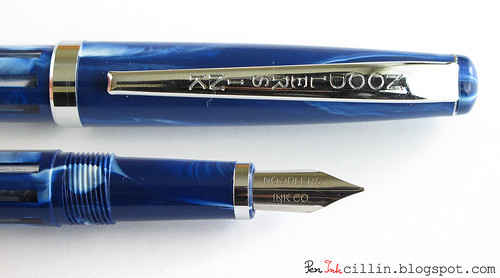
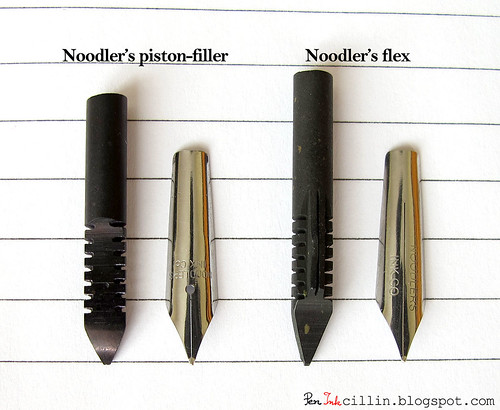


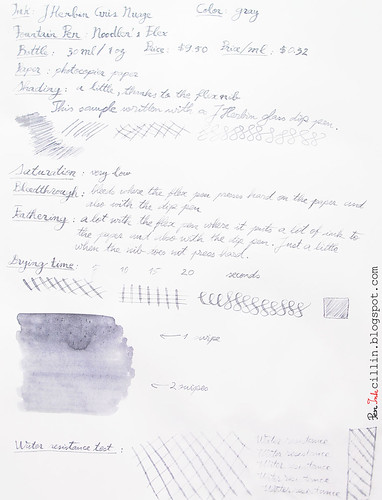
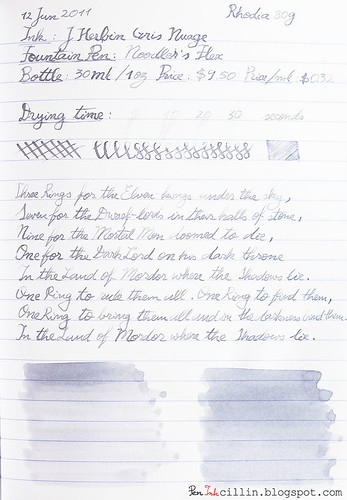
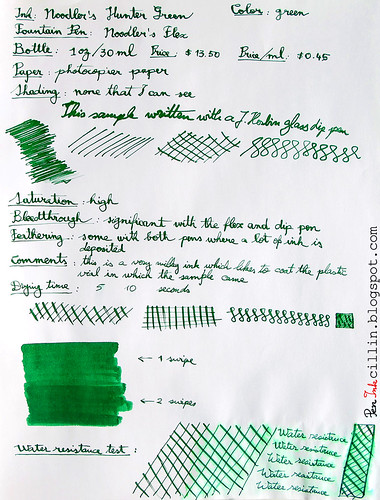

Thanks for a great review. I have one of the original Noodler's Flex pens and I also received an Ahab demonstrator that I need to find the time to play with. ;-) A friend called me to say that she was having ink flow issues with her Ahab so I'll have to see how I get along with mine.
ReplyDeleteI just got my Ahab today too! What kind of flow issues is she having? Not enough or too much? The key is to play with the nib and feed, perhaps even remove the feeder tube that goes into the feed. I still have to ink mine up but not before I can shoot some photos of it.
ReplyDeleteShe fills it with ink, writes a bit, and then it seems to stop flowing. She has a demonstrator so she can easily see the ink in the barrel.
ReplyDeleteAfter reading your article here, I forwarded it to her to give her some ideas about playing with the nib and feed.
The nib/feed method deals with dryness/wetness but she seems to have ink supply issues. I'm inclined to think it's because she didn't wash the insides really well with soapy water. It's a good idea to do that to a brand new pen because very often they have manufacturing oils sticking to the plastic, preventing the ink from flowing.
ReplyDeleteThe feed and piston mechanism are the biggest culprits. If soapy water doesn't work, soak them in ammonia solution. Oh, make sure to rinse them with water really well afterwards.
She did claim that she flushed it out first. Whether or not she used soapy water or an ammonia solution, I have no idea.
ReplyDeleteSoap (or rather dish detergent) is much better than plain water because it cuts through those oils. My Ahab actually had particles of... stuff inside the piston and on the feed.
ReplyDeleteDid you just flush it or did you take the pen apart to clean it?
ReplyDeleteI took it apart and cleaned the parts individually. That's what I love about this pen - it's so easy to take apart and clean.
ReplyDeleteI really enjoy your blog and i really like your ink reviews. Sorry if you mentioned this ihest but what color inj did you use in the post. I am really loving that red you used
ReplyDeleteThanks! I used J Herbin Gris Nuage and Noodler's Hunter Green.
ReplyDeleteWhere are these pens manufactured?
ReplyDeleteI don't know exactly. There's a thread on FPN talking about this if I'm not mistaken. I believe the parts are sourced from different places, including the US and India.
ReplyDeleteHi
ReplyDeleteJust found your blog - not good for someone who already spends far too much money on this stuff!
Anyway, I'd be interested to know if anyone has used this for copperplate/Spencerian or any of the classic hands. I bought one specially to try - well, that and an attempt to stop drowning the cat every time I knock the ink bottle over - and although I can get good flex with it I can't get the very fine hairlines. I've adjusted the feed and nib every which way - am I expecting too much of what is an absolute bargain?